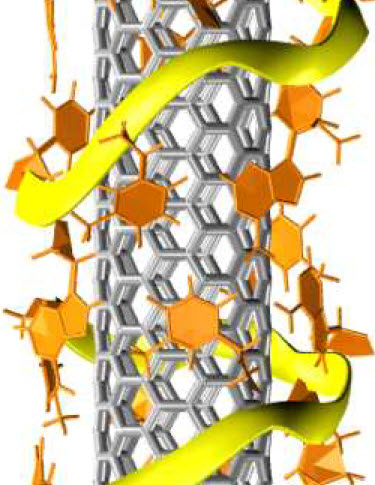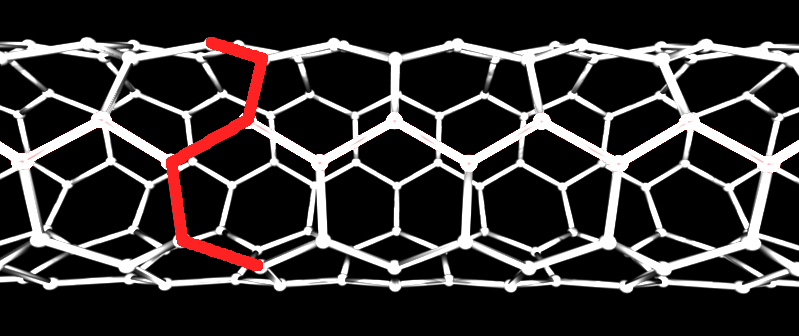DNA-purified nanotubes are step toward superconducting ‘quantum wire’
August 4, 2011

A single-strand DNA molecule (yellow ribbon) coiled around an "armchair" carbon nanotube (credit: Roxbury, Jagota/NIST)
Researchers at the National Institute of Standards and Technology (NIST) have found how tailored single strands of DNA can be used to purify the highly desired “armchair” form of carbon nanotubes needed to make superconducting “quantum wires” for low-loss, long-distance electricity transmission and wiring.
The researchers selected a DNA strand with a particular affinity for the desired “armchair” type of nanotube. They had previously demonstrated DNA strands that could select for one of the semiconductor forms of carbon nanotubes, an easier target.
They are now able to methodically step through simple mutations of the semiconductor-friendly DNA to “evolve” a pattern that preferred the metallic armchair nanotubes instead.

Armchair carbon nanotube design (credit: Wikimedia Commons)
Once the target nanotubes are enveloped with the DNA, standard chemistry techniques such as chromatography can be used to separate them from the mix with high efficiency. The DNA forms a tight barrel around the nanotube, creating a “kind of a lock and key.” The armchair nanotube is a key that fits inside this DNA structure — a form of molecular recognition, the researchers said.
Armchair carbon nanotubes that behave like metals could revolutionize electric power systems, large and small, the researchers said. Wires made from them are predicted to conduct electricity 10 times better than copper, with far less loss, at a sixth the weight.
Ref.: Xiaomin Tu, et al., Evolution of DNA Sequences Toward Recognition of Metallic Armchair Carbon Nanotubes, Journal of the American Chemical Society, 2011; : 110728080027017 [DOI: 10.1021/ja205407q]
Ref.: Xiaomin Tu, et al., DNA sequence motifs for structure-specific recognition and separation of carbon nanotubes, Nature, 2009; 460 (7252): 250 [DOI: 10.1038/nature08116]